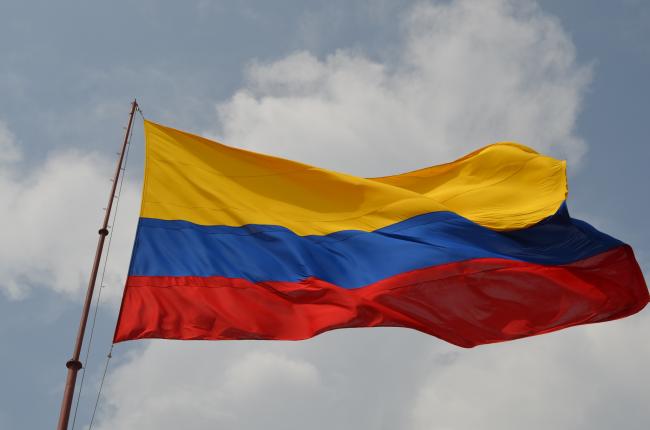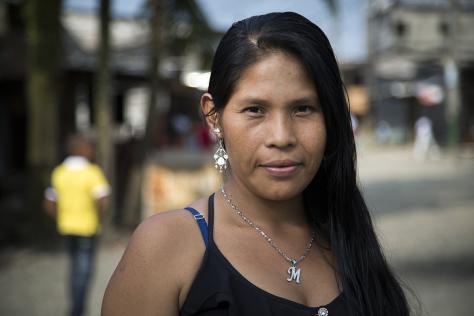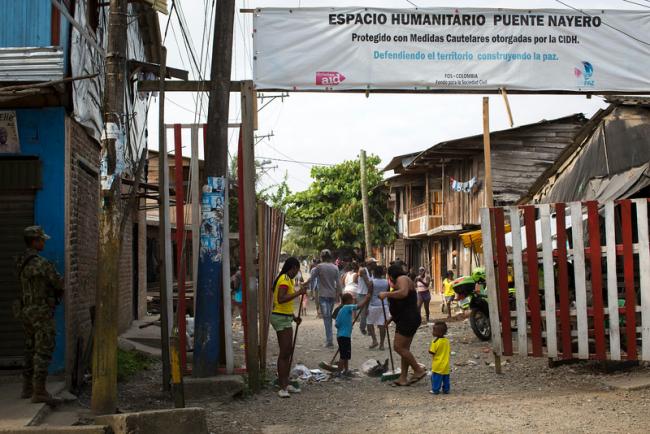
Since the historic November 30th ratification of the peace accord in Colombia between the FARC and the Colombian government, 15 activists have been killed, most recently Emilsen Manyoma Mosquera and her partner Joe Javier Rodallega. They were killed in the wake of an international celebration of the long-last ratification of the Colombian peace accords between the FARC and Colombian government.
Meanwhile, Colombians, scholars, and international solidarity groups have contemplated the long path to peace building and the risks ahead. They know their work is just beginning. At its most basic, post-accord Colombia is one in which paramilitaries, corporations, and the state are seeking to forcefully reinsert themselves into previously guerrilla-held territories, lands that predominantly belong to displaced Afro-Colombians and Indigenous peoples. As such, Afro-Colombian and Indigenous peoples are facing violence, threats, and terror as they try to reclaim stolen land and keep the land they have. We have heard this story before.
After having depicted a cozy image of a Colombia at peace, the media now seems fairly absent from the scene. This is one of many reasons why solidarity work is imperative. It exposes what the media won’t. It highlights international complicity with transnational violence, and shows us how our own liberation is tied to that of others.
As the Right rises, the Left must strengthen to protect, empower, and amplify the voices of the marginalized. An intersectional and more horizontal approach to solidarity has the potential to underscore international commonalties and facilitate the transfer of knowledge and skills that can strengthen activist movements.
U.S. solidarity with Colombia must continue to respond to atrocities, but it must also move beyond reactionary measures and work towards creating an alternative future.
What Can U.S.-Colombia Solidarity Do?
During his first week in office, President Trump gagged the USDA, the EPA, and the National Parks Service, among other agencies. He signed executive orders authorizing the continuation of the Keystone XL and Dakota Access Pipelines and expanding deportation while limiting immigration. His nominee for Secretary of State, Rex Tillerson, stated that the United States may no longer support the peace agreement between the Colombian government and the FARC, and the President signaled that he may withdraw support from it. In his short time in office, he has further threatened and criminalized already marginalized peoples.
Meanwhile, Colombians seek peace with a government that is resistant to addressing the root of the conflict—neoliberal economics and concurrent militarism. In fact, the accord explicitly refused to contend with the country’s existing economic model. Instead, the ratification of the accord opens up a space for greater international corporate investment in Colombia and, therefore, more Indigenous, Afro-Colombian, and campesino displacement.
Though the disarmament of the FARC is a victory, the narrow win of the “No” vote during the country-wide plebiscite is indicative of the long road ahead. The results of the plebiscite point to the divide between those in Colombia who have been impacted by the conflict and those who have not. They also demonstrate growing support for the Colombian Right—particularly its influential leader, former president Alvaro Uribe— and perhaps its awakening after a period of dormancy.
Arguably, Trump’s election implies the victory of such Uribe-esque trends in the United States— the rise of the Right. Though the contexts differ greatly, there are parallels among the most affected groups: Indigenous communities, impoverished peoples, women, children, people of color, displaced people (including immigrants), and people of African descent. More to the point, Colombia and the U.S. are connected in struggles against the Right and toward forming a more cohesive Left and alternative political project.
Though rarely discussed up to this point, Trump’s election is not just a menace to marginalized peoples in the United States, but those in Colombia as well. After years of activism, the Obama administration finally came to support peace negotiations in Colombia, even sending a U.S.-based mediator, Bernie Aronson, to observe and facilitate. Though the specifics were contested among social groups, Obama also promised Colombia a $450 million aid package, called “Peace Colombia,” which would also fund NGOs. Unlike previous U.S. aid packages offered to Colombia, “Peace Colombia” would be the first that was not earmarked primarily for military aid. Though this shift represented a positive change, some insisted that this funding would be better used if it went to local grassroots Colombian organizations. However, with increasing violence in Colombia and the rise of the Right, it is important that the United States at least rhetorically, if not financially, support the implementation of the accord.
If the United States withdraws its support of the deal, it would further legitimate former President Alvaro Uribe’s disapproval of the agreement and his hardline militarized strategy (long aided and supported by the United States), an approach that has killed hundreds of thousands and displaced millions. Essentially, the Trump administration would help tip the scales towards the Right in the region, as Colombia faces the growing influence of paramilitaries and the violence they perpetrate. We have seen how outright legitimation and impunity for right-wing paramilitaries has affected Indigenous peoples, Afro-Colombians, and campesinos in the past under Plan Colombia: mass displacement, violence, impunity, and terror.
These are all issues Colombian activists have long faced that could deepen without international and U.S. support for the peace process. These threats highlight the need for a more horizontal solidarity that could benefit both the United States and Colombia.
Solidarity and Alternatives
To understand the future of U.S.-Colombia solidarity, we must look back to the origins of the movement. U.S. solidarity and advocacy in Colombia emerged in the midst of the reign of international human rights discourse in the 1990s. This discourse is internationally understood and has been used to highlight violent and inhumane situations and create the political pressure needed for change. As paramilitary, guerrilla, and state violence soared in Colombia, the urgency of combatting violence and terror undermined counter-hegemonic alternatives to the reigning economic, social, and political system (such as socialism), as Lesley Gill explains in her book A Century of Violence in a Red City.
Under this current human rights framework, U.S. solidarity efforts have been used in an effort to create the safety and time that groups and individuals need to organize and maintain relationships, including those that build opposition to the existing structures of violence and marginalization. Solidarity efforts today include physical accompaniment, internet solidarity, popular education, and joint campaigns. Many of these methods are reactionary—they react to the murder of Colombian activists, they react to threats and displacement— and they campaign against U.S. military aid to Colombian troops.
Over the years, many have recognized the weaknesses of human rights discourse, including its elision of historical and political circumstances, the decontextualization of victims, the various meanings of “rights,” and its narrow framework for understanding options of change.
And yet, threatened communities in Colombia continue to ask for the accompaniment of foreigners to protect them, allow foreign travelers into their communities and homes, and hope that these visitors will take their new knowledge back home and affect change. During a short trip to Colombia in December 2016 with Witness for Peace, almost every community and activist group we met with, from Urabá to Northwest Colombia, indicated the need for more “solidarity.” However, the meaning of “solidarity” depended on whom you asked.
When I asked Carlos Montoya of the Instituto Popular de Capacitación (Popular Training Institute) in Medellin what he thought about U.S.-Colombia solidarity, he questioned what I meant by "solidarity." He facetiously asked if I meant the U.S.-funded fumigation efforts that kill food crops, pollute the water, and displace people. When I clarified that I meant grassroots solidarity organized against such policies, his demeanor markedly changed. “We need more of that solidarity,” he said. Carlos’ reaction to the use of “solidarity” in different contexts highlights the various ways the term has been applied—we must be careful to consider with what kind of solidarity we hope to engage.
Others saw solidarity as the act of sharing what is happening in Colombia with people in the United States. Some wanted to make connections with analogous groups or communities in the United States like Black Lives Matter or Native American communities. One thing was certain: people sought more than just a one-off chance to tell their stories. They wanted to use their stories as building blocks for bridges between countries, bridges that allow for the flow of information, ideas, and joint strategies.
This is the type of solidarity we need now.
Witness for Peace recently brought a Colombian Indigenous activist, Marcia Mejia Chirimia, on a three-week speaking tour across the Southeastern United States. Marcia met with students, professors, activists, and church-goers to discuss the peace talks in Colombia, the role of ethnic communities, and the need for continued solidarity. While in the United States, Marcia learned about the ongoing resistance of the Standing Rock Sioux. In a speech at a fundraising event for Standing Rock, Marcia noted that the threat of displacement, intimidation from security forces, and the menace of powerful wealthy businesses that the Standing Rock peoples face are also experienced by Indigenous, Afro-Colombian, and campesino communities in Colombia.

In noting these similarities, Marcia highlighted the importance and influence transnational solidarity could have if it occurred more frequently between international peoples who share experiences of racial, ethnic, class, and/or gender discrimination. Moreover, she highlighted the importance of an intersectional and international analysis of solidarity work.
As Afro-Colombians, Indigenous peoples, and campesinos are killed in Colombia and the Trump administration vows to move forward with the construction of the North Dakota pipeline, this analysis of solidarity is crucial. As Héctor Riveros writes in La Silla Vacía, Trump’s actions in his first week in office drove home a point that Latin American activists and people of color in the United States have been arguing for years: that the U.S.-led neo-colonial and extractivist model of development is problematic and harmful.
Privileged groups are finally becoming aware of what others have been experiencing for decades. This new awareness has the power to strengthen movements internationally as we re-engage with a discourse that focuses on a future we want to create. The threats posed by Trump have brought to the forefront debates about, as Riveros writes, “the guarantee of fundamental rights, even of those who are accused of crimes, the value of control systems for public authorities, the vision of sustainable development, [and] the importance of having unified positions among countries with common histories like those in Latin America.” Trump’s actions could mean a popular resurgence of anti-imperial discourse beyond the Far-Left.
If we are blind to how the Right is growing and working internationally, we are unable to see the whole picture, and thus we are not uniting to fight the threat. What is happening in Colombia and what is happening in the United States is the same and it is different. Many of the mechanisms, such as extractivist company displacing marginalized peoples, are the same, but the experiences are lived differently. We cannot understand these differences and similarities without an ongoing conversation. We cannot create an alternative future that works for all unless we understand how we all experience the present.
This type of intersectional solidarity requires that white people, middle- and upper-class people, and those with a variety of other privileges continue to think and consciously act in a manner that accounts for such differences. It means that people who are not affected by a policy must listen to and believe in the stories and voices of those who are affected.
 An example of this solidarity occurred in November 2016 when FOR Peace Presence, a non-profit organization that promotes solidarity in Colombia, organized a three-week tour and training program in the United States for Afro-Colombian activists. Throughout the tour, Afro-Colombian activists from The Puente Nayero Humanitarian Space worked with the Black Lives Matter movement to strengthen international bonds between Black communities. The group’s stated goal for the encounter was “to make connections across the Americas, allowing our different Black movements and organizations to become stronger.” The collaboration of this small community with the Black Lives Matter movement provides an example of what a more horizontal, international solidarity might look like— a conversation between people undergoing similar circumstances on how to battle against them more effectively.
An example of this solidarity occurred in November 2016 when FOR Peace Presence, a non-profit organization that promotes solidarity in Colombia, organized a three-week tour and training program in the United States for Afro-Colombian activists. Throughout the tour, Afro-Colombian activists from The Puente Nayero Humanitarian Space worked with the Black Lives Matter movement to strengthen international bonds between Black communities. The group’s stated goal for the encounter was “to make connections across the Americas, allowing our different Black movements and organizations to become stronger.” The collaboration of this small community with the Black Lives Matter movement provides an example of what a more horizontal, international solidarity might look like— a conversation between people undergoing similar circumstances on how to battle against them more effectively.
As Marcia concluded her talk, she said, “We ask you to stand up and unite with our efforts so we can be able to resist and reclaim our rights…We know that if other people stand up and unite, our effort can win.”
We can all win. But we have to rethink solidarity. Too often, we fail to contextualize foreign events within the globalized world in which we live. We forget that we are not just connected by the political events in our own country, but by those around the world. In their 2011 book Walk Out, Walk on, Margaret Wheatley and Deborah Frieze suggest a solidarity method called “scaling across.” In this method, people find solutions that work in their local context. Word travels, and by engaging in conversation, others try to learn how to alter the methodology to work in their own local conditions. In scaling across, people engage in solidarity by learning from each other and making changes as they go along.
Instead of a one-sided solidarity, in which people with more privilege leverage their power to amplify the voices of others, scaling across operates on a more balanced scale in which people grow in understanding, strength, and tactics by learning from one another. This type of solidarity is a continued conversation that builds resistance, scale, understanding, and strength. Marcia Mejia Chirimia’s speech in solidarity with Standing Rock was a microcosm of what this type of solidarity could look like. Now is the time to draw from this collective will and create a united political project.
International solidarity work can craft peace. It can make the global local, and the local global. It can provide empowerment and support for marginalized groups. It can increase awareness on the part of those blissfully ignorant of neoliberalism’s ills. And it can increase the pressure on politicians to change policies.
With Trump in office, the question is no longer whether or not we have time for international solidarity work. As the Right flexes its muscles, so too must the Left. We must build bridges that strengthen the voices of those the Right would like to silence and remain in conversation across borders to create an alternative political project. We must not just be in solidarity. We must act in solidarity.
Chelsey Dyer is a PhD student in anthropology at Vanderbilt University. Her research focuses on U.S.-Colombia solidarity efforts.

